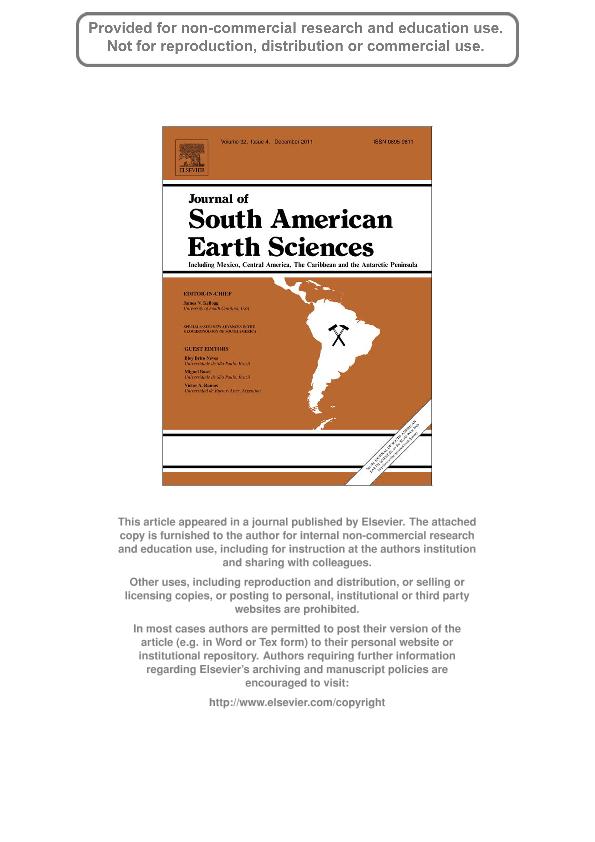Mostrar el registro sencillo del ítem
dc.contributor.author
Fanning, C. Mark
dc.contributor.author
Hervé, Francisco

dc.contributor.author
Pankhurst, Robert

dc.contributor.author
Rapela, Carlos Washington

dc.contributor.author
Kleiman, Laura Elena

dc.contributor.author
Yaxley, Greg M.
dc.contributor.author
Castillo, Paula
dc.date.available
2023-05-05T11:09:09Z
dc.date.issued
2011-01
dc.identifier.citation
Fanning, C. Mark; Hervé, Francisco; Pankhurst, Robert; Rapela, Carlos Washington; Kleiman, Laura Elena; et al.; Lu-Hf isotope evidence for the provenance of Permian detritus in accretionary complexes of western Patagonia and the northern Antarctic Peninsula region; Pergamon-Elsevier Science Ltd; Journal of South American Earth Sciences; 32; 4; 1-2011; 485-496
dc.identifier.issn
0895-9811
dc.identifier.uri
http://hdl.handle.net/11336/196386
dc.description.abstract
Lu-Hf isotope data are presented for dated Permian zircon grains from six samples of the latest Palaeozoic to Jurassic low-grade metasedimentary rocks of western Patagonia and the northern Antarctic Peninsula, as well as from potential source rocks in the North Patagonian Massif. The results for the metasedimentary rocks yield eHf values mostly between _15 and þ4 (130 analyses), with a dominant range (more than 85%) of _6 to þ1, indicating provenance from Permian magmatic rocks that incorporated continental crust with a significant residence time. Other zircon grains record more negative eHf values indicating derivation from yet more mature crustal sources. Permian subvolcanic granites in the North Patagonian massif appear to be the closest large source area and dated zircon grains from eight samples of these granites yield initial of eHf values of _12 to þ4 (45 measurements), 84% of which fall between _6 and þ1, the range shown by the metasediments. However, the North Patagonian massif also contains some more juvenile PermianeCarboniferous components not seen in the metasediments, so that this may not be the primary or unique source. These granites are considered to represent the southernmost extension of the Choiyoi igneous province, which contains abundant Permian rhyolites that crop out on the eastern side of the Andes in central Argentina, for which unpublished Hf isotope data yield a very similar range to that of the metasediments. The widespread nature of the Choiyoi volcanic rocks and the predominance of Permian zircon could make this a more favoured source for the detrital grains. Hf isotope data reinforce the uniformity of the provenance of the turbidite detrital zircons and confirm the Choiyoi igneous province and the Permian granitic rocks of the North Patagonian Massif as feasible sources. They further confirm the dominantly crustal origin of the Permian magmas. A source region involving mixing of, for example, crustal materials of Panafrican/Brasiliano and Grenvillian ages, together with a minor but significant subduction-related magmatic input, is an isotopically feasible explanation and is broadly consistent with the provenance of pre-Permian crust in this region, but the proportions of such a mixture must have remained relatively constant. This supports the proposal that recently recognized but widespread Permian magmatism in Patagonia represents voluminous crustal melting in response to subducted slab break-off. The results are also consistent with the premise that the Antarctic Peninsula and southern Patagonia were closely located from Permian to Jurassic times, receiving detritus from the same source.
dc.format
application/pdf
dc.language.iso
eng
dc.publisher
Pergamon-Elsevier Science Ltd

dc.rights
info:eu-repo/semantics/openAccess
dc.rights.uri
https://creativecommons.org/licenses/by-nc-sa/2.5/ar/
dc.subject
ANTARCTIC PENINSULA
dc.subject
HF ISOTOPES
dc.subject
PATAGONIA
dc.subject
PERMIAN
dc.subject
PROVENANCE
dc.subject
ZIRCON
dc.subject.classification
Geología

dc.subject.classification
Ciencias de la Tierra y relacionadas con el Medio Ambiente

dc.subject.classification
CIENCIAS NATURALES Y EXACTAS

dc.title
Lu-Hf isotope evidence for the provenance of Permian detritus in accretionary complexes of western Patagonia and the northern Antarctic Peninsula region
dc.type
info:eu-repo/semantics/article
dc.type
info:ar-repo/semantics/artículo
dc.type
info:eu-repo/semantics/publishedVersion
dc.date.updated
2023-04-10T10:16:23Z
dc.journal.volume
32
dc.journal.number
4
dc.journal.pagination
485-496
dc.journal.pais
Estados Unidos

dc.description.fil
Fil: Fanning, C. Mark. Australian National University; Australia
dc.description.fil
Fil: Hervé, Francisco. Universidad de Chile; Chile
dc.description.fil
Fil: Pankhurst, Robert. British Antartic Survey; Reino Unido
dc.description.fil
Fil: Rapela, Carlos Washington. Consejo Nacional de Investigaciones Científicas y Técnicas. Centro Científico Tecnológico Conicet - La Plata. Centro de Investigaciones Geológicas. Universidad Nacional de La Plata. Facultad de Ciencias Naturales y Museo. Centro de Investigaciones Geológicas; Argentina
dc.description.fil
Fil: Kleiman, Laura Elena. Comisión Nacional de Energía Atómica; Argentina
dc.description.fil
Fil: Yaxley, Greg M.. Australian National University; Australia
dc.description.fil
Fil: Castillo, Paula. Universidad de Chile; Chile
dc.journal.title
Journal of South American Earth Sciences

dc.relation.alternativeid
info:eu-repo/semantics/altIdentifier/url/https://www.sciencedirect.com/science/article/abs/pii/S0895981111000319
dc.relation.alternativeid
info:eu-repo/semantics/altIdentifier/doi/http://dx.doi.org/10.1016/j.jsames.2011.03.007
Archivos asociados
